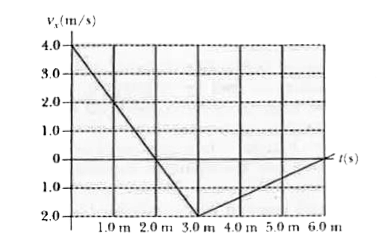If the velocity of a paraticle moving along x-axis is given as v=(4t2+3t−1)m/s then acceleration of the particle at t=1sec is :
11m/sec2
8m/sec2
7m/sec2
5m/sec2
The correct Answer is:A
v=4t2+3t−1
dvdt=accn=8t+3
a∣t=1=8×1+3=11m/sec2
Topper's Solved these Questions
Similar Questions
Knowledge Check
- Question 1 - Select One
If the velocity of the a particle moving on x-axis is given by v=3t2−12t+6. at what time is the acceleration of particle zero ?
A2 secB2+√2secC2−√2secDzero - Question 2 - Select One
Velocity of a particle is given as v=(2t2−3)m/s. The acceleration of particle at t = 3s will be :
A18ms−2B12ms−2C15ms−2Dzero - Question 3 - Select One
The position of a particle moving along x-axis given by x=(−2t3−3t2+5)m. The acceleration of particle at the instant its velocity becomes zero is
A12m/s2B−12m/s2C−6m/s2DZero
Velocity (in m/s) of a particle moving along x-axis varies with time as, v=(10+5t−t2) At time t=0,x=0. Find
(a) acceleration of particle at t=2s and
(b) x-coordinate of particle at t=3sView SolutionThe velocity time relation of a particle is given by v =(3t2−2t−1)m/s Calculate the position and acceleration of the particle when velocity of the particle is zero . Given the initial position of the particle is 5m .
View SolutionThe velocity of a particle is given by v=(2t2−3t+10)ms−1. Find the instantaneous acceleration at t = 5 s.
View SolutionThe displacement (in metre) of a particle moving along X-axis is given by x=18t+5t2. The average acceleration during the interval t1=2s and t2=4s is
View Solutionvx is the velocity of a particle moving along the x-axis as shown in the figure. If x=2.0m at t=1.0s, what is the position of the particle at t=6.0s ?
 View Solution
View Solution

